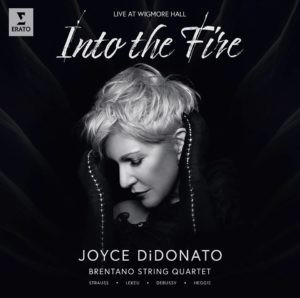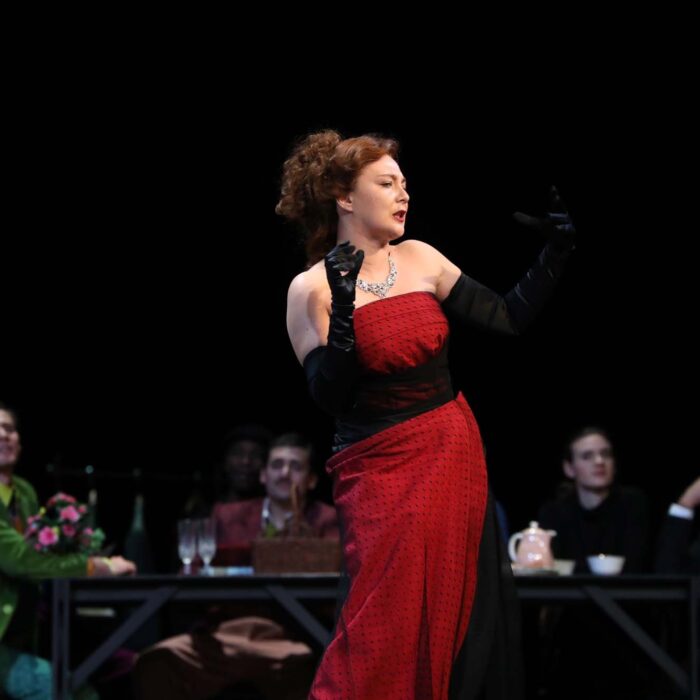
Joyce DiDonato Launches New Album At Greene Space
By Logan MartellThis past month Joyce DiDonato released a new recording entitled “Into the Fire.” The new album, which was recorded live at London’s celebrated Wigmore Hall, features the Brentano Quartet and was conceived around Jake Heggie’s song cycle “Camille Claudel: Into the Fire,” a work written for DiDonato.
To celebrate the launch of the album, DiDonato and the Brentano Quartet performed selection at the Greene Space in New York City.
The event started with WXQR’s Clemency Burton speaking with Joyce DiDonato, and Mark Steinberg of the Brentano String Quartet, to learn more of the process behind the new album.
Clemency Burton: “I wondered if we can start by talking about the concept for the album ‘Into the Fire’ that we’re going to be hearing music from this evening.”
Joyce DiDonato: “So we had a series of two recitals last December at Wigmore Hall in London. And we had performed Jake Heggie’s “Camille Claudel” cycle “Into the Fire” a few times and we wanted to bring it to Wigmore Hall, and we surrounded it with some other works that supplement it very well. The theme was around Camille, and around France, and that epic, kind of tragedy and melancholy of her story. The first concert felt really special, I have to say, and we all came off, the next concert was in two days, and I said ‘I think we should record this.’ A few phone calls were made and in 24 hours, literally at Christmas-time, we had a producer and we all just jumped into the fire to make this happen and we did it in one live recording.”
CB: “Mark, you, as a quartet, have performed with some great collaborators over the years. Voice and string quartet, that’s quite an unusual combination. What are the challenges and what are the joys of working with DiDonato?”
MS: “I don’t think of it in terms of challenges, I think of it in terms of inspirations. It’s an incredible honor and pleasure, and joy, to work with someone of Joyce’s caliber and humanity, and generosity, and imagination. Of course there are many times we talk about the string instruments wanting to get close to the human voice, so it’s a good way to feel very self-conscious and inferior to have a beautiful singer in your midst – but it’s also a good way to try to raise your game and find every color, nuance, possibility for expression that you can, in order to try to enter these incredible, dramatic, and colorful worlds that Joyce is creating right there. She also, besides being an incredible singer and artist, just listens so beautifully, so it feels so vital and alive, the interaction that goes on as we’re playing; that’s why we do chamber music, and we’re really lucky.”
“JD: “He’s also being very generous. Because I’ll throw stuff out that has no technical grounding at all, saying ‘can we try this, or play with the color?’ and somehow they know how to interpret my crazy ideas into something technical that works. As you say, it’s alive and we have the chance – oftentimes my role on the stage is over the orchestra, which can feel like one entity, and here’s this entity of a quartet, but with four really distinct sounds that are especially used by Jake for real, colorful, dramatic effect. The joy of being a quintet at this point, to play with colors, bounce ideas, and hand off the baton to each other has been, for a vocalist, a real gift to be able to go into chamber music.”
CB: “Claudel’s life is one of operatic dimension in many ways. Jake Heggie has compressed it in a most wonderfully-nuanced way, and I’m wondering, Joyce, about being able to take this operatic life, and to bring her alive in a song cycle rather than an operatic form.”
JD: “Of course it’s a pleasure because I think it’s a masterpiece, and to perform it is one thing, but – and it’s interesting because since Jake had seen the film from the 80s, he knew that he wanted to write an opera about it. And a commission came up to do it with a string quartet in a song cycle, and he wanted to start with the Camille story, but as he went into it he confessed ‘Joyce, it’s too dark a world. I don’t want to stay there for three hours, I think I’ve said everything I needed to say with this.’ It would be an incredible opera, no doubt about it, but I think the ‘nakedness’ of this intense piece, which holds you for 35-40 minutes, and the vulnerability of not a full string section, but a trembling string as she converses with different sculptures, there is something much more focused and I think more poignant than what you can get in an opera, which sounds like a discrepancy. Somehow, it is more intimate, which makes it more intense, and her voice feels somehow more concentrated.”
From Into the Fire.
“Jake Heggie and Gene Scheer have brought Camille to vivid, heartbreaking light in their cycle ‘Camille Claudel: Into the Fire.’ While not quite a literal narrative, the idea is that the cycle takes place the night before she is committed to the asylum. Remembrances of the passion she felt for Rodin, the complexity of their fiery relationship, the loss of her unborn child, the anger and resolve around her artistic vision all lead to profound heartbreak as she walks into her future of captivity. It is now to be a life without movement, a life of stillness and disconnect. Isolation.”
Without further ado, DiDonato and the Brentano String Quartet performed the half-hour song cycle which makes up the heart of her new album. As the quartet began to play, the rhythm soon became that of a lilting waltz, over which the violin performed a series of sorrowful runs; the fixation of the rhythm created a sense of sad obsession which would unfold itself further throughout the cycle. The opening stanza of the first song, fittingly titled “Rodin,” saw DiDonato recollecting a dream of love; the yearning of her lyricism quickly shifted to more scornful tones with the phrase “Everything burned away in the cruel morning light.” The closing phrases of this song “In the clay, I search with my fingers for something true,” wonderfully connected Claudel’s inner turmoil with her artistry shortly before DiDonato unleashed a frantically-powerful climax calling the name of Rodin, which repeated itself softly into a fading sigh.
The next song, “La Valse,” began with an energetic instability as the strings were punctuated with a quick but creeping pizzicato. As if reflecting on this, DiDonato’s more lyrical delivery made for a fitting contrast, her voice and the strings seemed to highlight one another as DiDonato sang “Console my eyes with beauty, allow me to forget that every dance of love is mingled with regret.” The final word was sustained in an ambiguous way as if one stopping mid-sentence when seized by a realization. The third song, “Shakuntala,” really outlined the theme of remembrance as many of the lines began with the word ‘before,’ for example “Before I was a mother… Before I met the king… Before he made his promise… etc.” DiDonato bestowed each repetition with a nuance that spoke to the uncertainty of Claudel’s identity in relation to herself, an uncertainty that was also reflected in the melodic dissonance of the violin.
The fourth song, “La Petite Chatelaine,” started with a relaxed plucking from the cello which coupled nicely with the gentle melody of the violin to create a woodland atmosphere. As Claudel converses with her small statues that she treats like children, there’s undoubtedly a more loving and tender undercurrent compared to previous numbers, though even this still bares the feelings of separation experienced by Claudel, as heard when DiDonato longingly sings “forever alone with my children of stone.” The final song is titled “Epilogue: Jessie Lipscomb visit Camille Claudel, Montdevergues Asylum, 1929,” and made for a hauntingly-sad conclusion to the cycle. The bright violin melody set a deceptive mood as Claudel engages in small talk which quickly rises in gravity. As Claudel reminisces on her past, DiDonato’s voice bore a heightened expressiveness on the sensory language “Touching. Breathing. Reaching. Hovering. Something always about to change…” The last words of the cycle, so concerned with motion and unrest, are delivered with a rueful grace from DiDonato: “A photograph? Just me and you. Yes. I understand. I must be very still. Thank you for remembering me.”
Watch the complete performance HERE: https://www.wqxr.org/story/watch-joyce-didonato-brentano-string-quartet-live-greene-space/
Categories
Special Features

